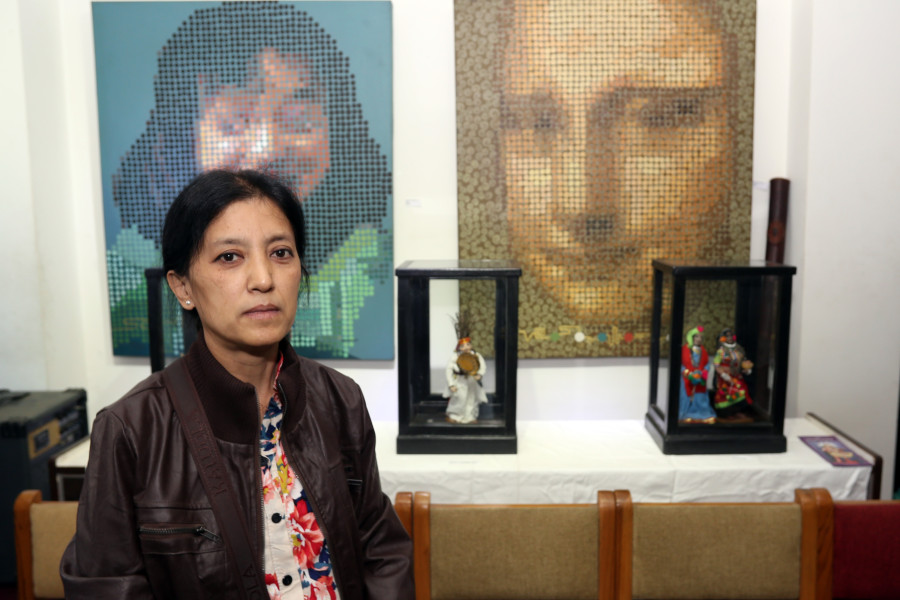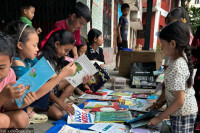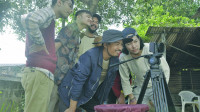Entertainment
The secret lives of dolls
“My dolls have souls,” says Padma Shree Shrestha. And on first glance, it appears that she might be right. These hundreds of dolls look alive, just about ready to step out of the glass frames they are comfortably housed in.
Timothy Aryal
“My dolls have souls,” says Padma Shree Shrestha. And on first glance, it appears that she might be right. These hundreds of dolls look alive, just about ready to step out of the glass frames they are comfortably housed in.
Shrestha collects dolls and out of the 3,500 in her collection, she’s handmade 700 of them over two decades. Thirty-three of these dolls are currently on display at the Music Art Gallery and Café in Jhamsikhel.
Two dolls, dubbed ‘Thakali couple’ welcome visitors to the show. Clearly a middle-aged couple, both husband and wife are wearing traditional Thakali garb that you don’t see anybody wearing these days. Solemn in demeanour, the husband has a stick in his hand, and is wearing what looks like a daura suruwal, grayish-white in colour, and a black waistcoat. He is carrying an intricately designed bag on his shoulders. He looks forward, into the distance. His eyes are world-weary and his mustache and goatee, slightly ruffled and amusing. His wife, standing next to him, likewise dons traditional bright-hued clothing—pink choli, yellow patuki and purple fariya—and heavy jewellery around her neck and both her hands.
This is a curious work of art, intricately detailed and deftly designed. Every little detail is outlined—they resemble a real-life couple rather than mannequins or even wax statues. One wonders just how much effort might have gone into putting this piece together.
Titled Ethnicity of Dolls, the exhibit has on display other such works representing a host of ethnic groups from around the country—Limbu, Newar, Tharu, Satar, you name it. But there are surprises—a stately piece replicates King Birendra’s family; another an elaborate scene from a Newar ‘supari’ and yet another from an apparent “Bangle ceremony”; and of course, living gods and goddesses.
“Much research and imagination have gone into these pieces,” says Shrestha matter-of-factly. Even though she’s studied the clothing and the culture, the faces are works of her imagination.

In conversation, Shrestha comes across as a down-to-earth person who knows what she’s doing. “To share my crafts with doll artists, doll collectors and doll lovers all over the world,” Shrestha outlines her objective in the exhibit’s brochure. “Creating dolls takes me back to my childhood. I think the seed of creativity is planted in my childhood. I have still with me the dolls of my childhood.”
Shrestha grew up playing with dolls, like every other child, but she says, also observing, studying and loving them.
Her grandmother would give her dolls to play with, but while toying with them, Shrestha would also sew and design clothes for them herself, utilising small, spare parts from her own clothing. That childhood passion continued into adulthood and middle-age. Though Shrestha has no formal education in the arts, she honed her craft taking lessons with veteran academic Govinda Dangol.
Shrestha has so far crafted over 700 dolls and each feels special and is close to her heart. “I love spending my time surrounded by dolls,” she says. “More than I do with humans.”

Shrestha’s work is housed at the National Museum in Chhauni, and has been exhibited six times so far, including twice in the US.
She began collecting dolls from around the world because she was fascinated by different cultures and ethnicities, she says. Ethnicity of Dolls, the ongoing exhibit, presents the audience with 30 different ethnicities from around Nepal. She takes part in a range of festivities, from Maghi to Lhosar every year, and converses with the people celebrating it. She pays close attention to their demeanour, hairstyle, belongings, way of life.
Creating these dolls appears to be her way of conversing with all these multifarious groups. Her dolls have become routine and she’ll continue with them for as long as she can, she says.
“To create dolls and to sit around them, it’s a heavenly feeling, a kind of meditation,” says Shrestha. “There’s nothing quite like it.”
‘Ethnicity of Dolls’ is currently on show at Music Art Gallery and Cafe in Jhamsikhel, Lalitpur, and will run till March 31.




 16.12°C Kathmandu
16.12°C Kathmandu










